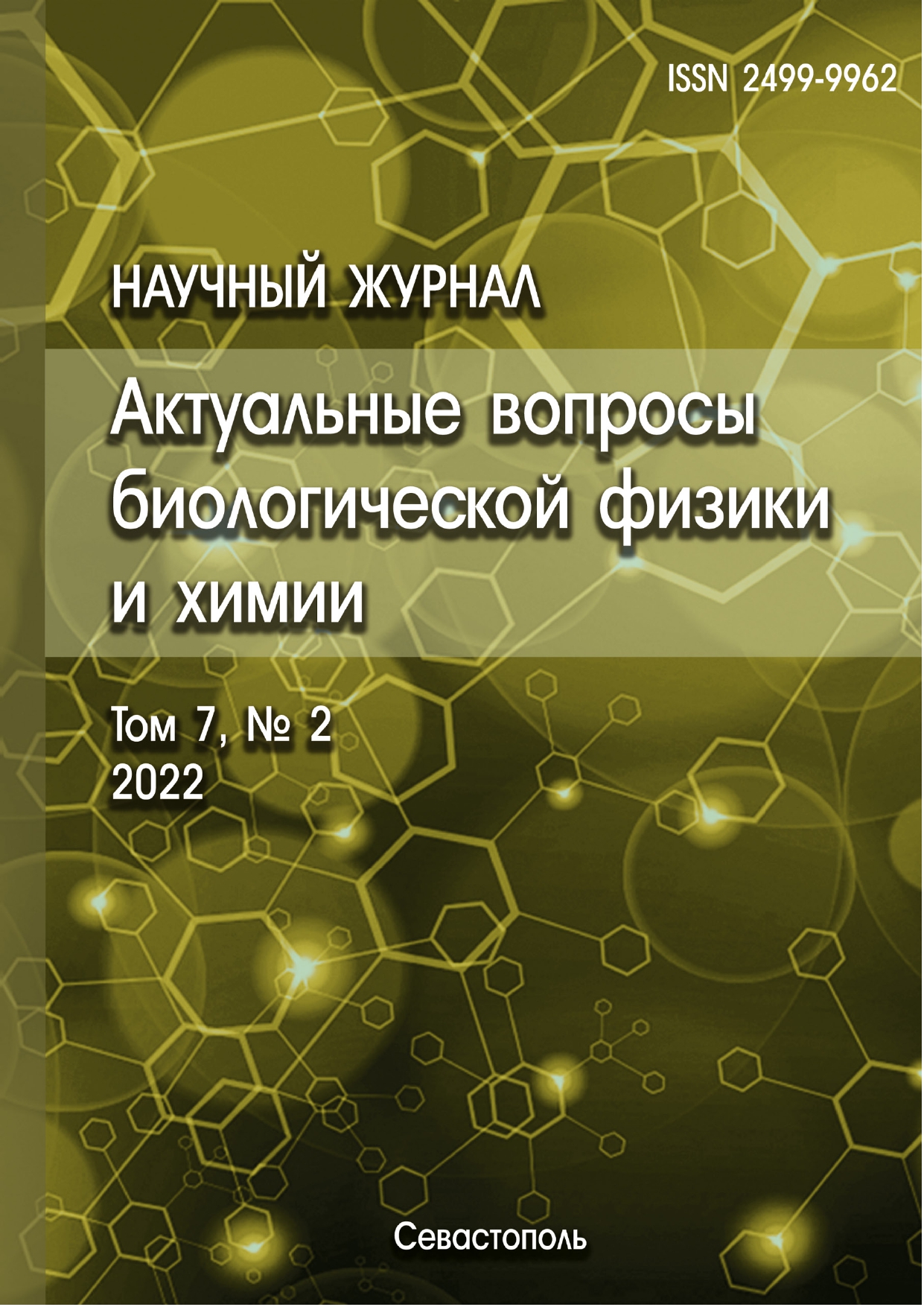Baku, Azerbaijan
The spatial and electronic structure of the natural carnosine dipeptide in the N3H tautomeric form of its imidazole ring in gas and water environment was studied by the quantum-chemical method in the framework of the electron density functional theory (DFT) with the three-parameter B3LYP hybrid functional. The sufficiently reliable and time-saving extended basis set, taking into account the polarization and diffuse functions 6-31+G (d, p) was used for calculations. All calculations were carried our using the Gaussian 09 software package. GaussView 6.0.16 was used to visualize the obtained results. Geometrical parameters, values of electronic energy, energies of HOMO and LUMO orbitals and the energy gap between them, reactivity descriptors, values of dipole moments, partial charges on atoms, and theoretical IR spectra for gaseous and aqueous media are obtained. Calculations show that the proposed model of the molecule forms a stable structure. The resulting structure is stabilized due to non-covalent interactions in the dipeptide. Molecular electrostatic potential maps (MEP) are constructed to identify potential binding sites. To study the charge transfer and intramolecular interactions that determine the stability of the molecule, an analysis of natural bond orbitals (NBOs) was carried out. Structural rearrangements and changes in various parameters depending on the dielectric constant of the medium are analyzed.
carnosine, structure, reactivity descriptors, NBO analysis, IR spectra
1. Boldyrev A.A., Problems and prospects of research of the biological role of carnosine. Biokhimiya, 2000, vol. 65, no. 7, pp. 884-890. (In Russ.)
2. Hipkiss A.R. Chapter 3: Carnosine and Its Possible Roles in Nutrition and Health. Advances in Food and Nutrition Research, 2009, vol. 57, pp. 87-154, doi: 10.1016 / S1043-4526 (09) 57003-9. DOI: https://doi.org/10.1016/S1043-4526(09)57003-9; EDN: https://elibrary.ru/MNDZNX
3. Gallant S., Kukley M., Stvolinsky S., Bulygina E., Boldyrev A. Effect of carnosine on rats under experimental brain ischemia. Tohoku J. Exp. Med., 2000, vol. 191, pp. 85-99, doi:https://doi.org/10.1620/tjem.191.85.
4. Prokopieva V.D., Yarygina E.G., Bokhan N.A. and Ivanova S.A.: Use of carnosine for oxidative stress reduction in different pathologies. Oxid Med Cell Longev, 2016, no. 29390872016, doi:https://doi.org/10.1155/2016/2939087. EDN: https://elibrary.ru/WPLKZL
5. Caruso G., Fresta C.G., Musso N. et al. Carnosine prevents Aβ-induced oxidative stress and inflammation in microglial cells: A key role of TGF-β1. Cells, 2019, vol. 8, p. 64, doi:https://doi.org/10.3390/cells8010064. EDN: https://elibrary.ru/CMFDUZ
6. Boldyrev A.A. Carnosine. Moscow: Publishing house of the Moscow State University, 1998, 320 p. (In Russ.)
7. Quinn P.J., Boldyrev A.A., Formazuyk V.E. Carnosine: its properties, functions and potential therapeutic applications. Mol Aspects Med., 1992, vol. 13, pp. 379-444, doi:https://doi.org/10.1016/0098-2997(92)90006-l. EDN: https://elibrary.ru/XOCGFS
8. Bonfanti L., Peretto P., De Marchis S., Fasolo A. Carnosine-related dipeptides in the mammalian brain. Prog.Neurobiol., 1999, vol. 59, pp. 333-353, doi:https://doi.org/10.1016/S0301-0082(99)00010-6. EDN: https://elibrary.ru/LTDPFV
9. Jain S., Kim E.S., Kim D., Burrows D., De Felice M., Kim M., Baek S.H., Ali A., Redgrave J., Doeppner T.R. et al. Comparative cerebroprotective potential of d- and l-carnosine following ischemic stroke in mice. Int. J. Mol. Sci., 2020, vol. 21, no. 9, pp. 3053-3065, doi:https://doi.org/10.3390/ijms21093053. EDN: https://elibrary.ru/MPLLOO
10. Zhao J., Posa D.K., Kumar V., Hoetker D., Kumar A., Ganesan S., Riggs D.W., Bhatnagar A., Wempe M.F., Baba S.P. Carnosine protects cardiac myocytes against lipid peroxidation products. Amino Acids, 2019, vol. 51, no. 1, pp. 123-138, doi:https://doi.org/10.1007/s00726-018-2676-6. EDN: https://elibrary.ru/WXWEPV
11. Zhao J., Shi L., Zhang L.-R. Neuroprotective effect of carnosine against salsolinol-induced Parkinson's disease. Exp. Ther. Med., 2017, vol. 14 no. 1, pp. 664-670, doi:https://doi.org/10.3892/etm.2017.4571. EDN: https://elibrary.ru/SVHZNZ
12. Calon F., Cole G. Neuroprotective action of omega-3 polyunsaturated fatty acids against neurodegenerative diseases: evidence from animal studies. Prostaglandins Leukot Essent Fatty Acids, 2007, vol. 77, no. 5-6, pp. 287-293, doi:https://doi.org/10.1016/j.plefa.2007.10.019.
13. Bermudez M.L., Seroogy K.B., Genter M.B. Evaluation of carnosine intervention in the Thy1-aSyn mouse model of Parkinson's disease. Neuroscience, 2019, vol. 411, pp. 270-278, doi:https://doi.org/10.1016/j.neuroscience.2019.05.026. EDN: https://elibrary.ru/EWBZNZ
14. Kilis-Pstrusinska K. Carnosine, carnosinase and kidney diseases. Postepy Hig Med Dosw, 2012, vol. 66, pp. 215-221, doi:https://doi.org/10.5604/17322693.991600. EDN: https://elibrary.ru/RQSRFV
15. Riedl E., Pfister F., Braunagel M., Brinkkötter P., Sternik P., Deinzer M., Bakker S.J., Henning R.H., van den Born J., Krämer B.K., Navis G., Hammes H.P., Yard B., Koeppel H. Carnosine prevents apoptosis of glomerular cells and podocyte loss in STZ diabetic rats. Cell Physiol Biochem., 2011, vol. 28, no. 2, pp. 279-288, doi:https://doi.org/10.1159/000331740.
16. Peters V., Zschocke J., Schmitt C.P. Carnosinase, diabetes mellitus and the potential relevance of carnosinase deficiency. J Inherit Metab Dis., 2018, vol. 41, no. 1, pp. 39-47, doi:https://doi.org/10.1007/s10545-017-0099-2. EDN: https://elibrary.ru/YEUTDV
17. Pfister F., Riedl E., Wang Q., vom Hagen F., Deinzer M., Harmsen M.C., Molema G., Yard B., Feng Y., Hammes H.P. Oral carnosine supplementation prevents vascular damage in experimental diabetic retinopathy. Cell Physiol. Biochem., 2011, vol. 28, no. 1, pp. 125-136, doi:https://doi.org/10.1159/000331721. EDN: https://elibrary.ru/PHMRWL
18. Rashid I., van Reyk D.M., Davies M.J. Carnosine and its constituents inhibit glycation of low-density lipoproteins that promotes foam cell formation in vitro. FEBS Lett., 2007, vol. 581, no. 5, pp. 1067-1070, doi:https://doi.org/10.1016/j.febslet.2007.01.082.
19. Mong M.C., Chao C.Y., Yin M.C. Histidine and carnosine alleviated hepatic steatosis in mice consumed high saturated fat diet. Eur J Pharmacol., 2011, vol. 653, no. 1-3, pp. 82-88, doi:https://doi.org/10.1016/j.ejphar.2010.12.001. EDN: https://elibrary.ru/XYIPFX
20. Boldyrev A.A., Aldini G., Derave W. Physiology and pathophysiology of carnosine. Physiol Rev., 2013, vol. 93, pp. 1803-1845, doi:https://doi.org/10.1152/physrev.00039.2012. EDN: https://elibrary.ru/SKWDVP
21. Hipkiss A.R., Baye E., de Courten B. Carnosine and the processes of ageing. Maturitas, 2016, vol. 93, pp. 28-33, doi:https://doi.org/10.1016/j.maturitas.2016.06.002. EDN: https://elibrary.ru/XTVXLH
22. Cararo J.H., Streck E.L., Schuck P.F., da C. Ferreira G. Carnosine and Related Peptides: Therapeutic Potential in Age-Related Disorders. Aging and Disease, 2015, vol. 6, no. 5, pp. 369-379, doi:https://doi.org/10.14336/AD.2015.0616. EDN: https://elibrary.ru/WVKTYX
23. Kawahara M., Tanaka K.-I., Kato-Negishi M. Zinc, Carnosine, and Neurodegenerative Diseases. Nutrients, 2018, vol. 10, no. 2, pp. 147-167, doi:https://doi.org/10.3390/nu10020147. EDN: https://elibrary.ru/VEEAIS
24. Shao L., Li Q., Tan Z. L-Carnosine reduces telomere damage and shortening rate in cultured normal fibroblasts. Biochemical and Biophysical Research Communications, 2004, vol. 324, no. 2, pp. 931-936, doi:https://doi.org/10.1016/j.bbrc.2004.09.136. EDN: https://elibrary.ru/LWLUCD
25. Hipkiss A.R. and Gaunitz F. Inhibition of tumour cell growth by carnosine: some possible mechanisms. Amino Acids, 2014, vol. 46, no. 2, pp. 327-337, doi:https://doi.org/10.1007/s00726-013-1627-5. EDN: https://elibrary.ru/SPNRPL
26. Gaunitz F., Hipkiss A.R. Carnosine and cancer: a perspective. Amino Acids, 2012, vol. 43, no. 1, pp. 135-142, doi:https://doi.org/10.1007/s00726-012-1271-5. EDN: https://elibrary.ru/PIOLBF
27. Chuang C.-H., Hu M.-L. L-Carnosine Inhibits Metastasis of SK-Hep-1 Cells by Inhibition of Matrix Metaoproteinase-9 Expression and Induction of an Antimetastatic Gene, nm23-H1. Nutr Cancer, 2008, vol. 60, no. 4, pp. 526-533, doi:https://doi.org/10.1080/01635580801911787. EDN: https://elibrary.ru/XXMQDZ
28. Hsieh S.-L., Hsieh S., Lai P.-Y., Wang J.-J., Li C.-C., Wu C.-C. Carnosine suppresses human colorectal cell migration and intravasation by regulating EMT and MMP expression. Am J Chin Med, 2019, vol. 47, no. 2, pp. 477-494, doi:https://doi.org/10.1142/s0192415x19500241. EDN: https://elibrary.ru/GDINXJ
29. Wu C.-C, Lai P.-Y, Hsieh S., Cheng C.-C., Hsieh S.-L. Suppression of carnosine on adhesion and extravasation of human colorectal cancer cells. Anticancer Res., 2019, vol. 39, no. 11, pp. 6135-6144, doi:https://doi.org/10.21873/anticanres.13821. EDN: https://elibrary.ru/AQWHUC
30. Shen Y., Yang J., Li J., Shi X., Ouyang L., Tian Y., Lu J. Carnosine inhibits the proliferation of human gastric cancer SGC-7901 cells through both of the mitochondrial respiration and glycolysis pathways. PLoS ONE, 2014, vol. 9, no. 8, e104632, doi:https://doi.org/10.1371/journal.pone.0104632. EDN: https://elibrary.ru/UUCKED
31. Zhang Z., Miao L., Wu X., Liu G., Peng Y., Xin X., Jiao B., Kong X. Carnosine inhibits the proliferation of human gastric carcinoma cells by retarding Akt/mTOR/p70S6K signaling. J. Cancer., 2014, vol. 5, pp. 382-389, doi:https://doi.org/10.7150/jca.8024.
32. Lee J., Park J.R., Lee H., Jang S., Ryu S.M., Kim H., Kim D., Jang A., Yang S.R. L-carnosine induces apoptosis/cell cycle arrest via suppression of NF-κB/STAT1 pathway in HCT116 colorectal cancer cells. In Vitro Cell Dev Biol Anim., 2018, vol. 54, pp. 505-512, doi:https://doi.org/10.1007/s11626-018-0264-4. EDN: https://elibrary.ru/JSHKEQ
33. Shu-Ling Hsieh, Jia-Huei Li, Cheng-Di Dong, Chiu-Wen Chen, Chih-Chung Wu. Carnosine suppresses human colorectal cancer cell proliferation by inducing necroptosis and autophagy and reducing angiogenesis. Oncol Lett., 2022, vol. 23, no. 2, p. 44, doi:https://doi.org/10.3892/ol.2021.13162.
34. Wu G. Important roles of dietary taurine, creatine, carnosine, anserine and 4-hydroxyproline in human nutrition and health. Amino Acids, 2020, doi:https://doi.org/10.1007/s00726-020-02823-6.
35. Demukhamedova S.D., Alieva I.N., Godjayev N.M. Spatial and electronic structure of monomeric and dimeric complexes of carnosine with zinc. J. Struct. Chem., 2010, vol. 51, no. 5, pp. 824-832, doi:https://doi.org/10.1007/s10947-010-0127-7. EDN: https://elibrary.ru/OKUEGP
36. Demukhamedova S.D., Alieva I.N., Gajiyev Z.I. Quantum chemistry investigation of the carnosine polymer complex with zinc. Fizika, 2010, vol. 16, no. 2, pp. 597-600.
37. Demukhamedova S.D., Alieva I.N. Hadjiev Z.I., Godjayev N.M. Ab initio study of the structure and vibrational spectrum of the carnosine molecule. Journal of Qafqaz University, 2009, no. 27, pp. 15-25. (In Russ.)
38. Demukhamedova S.D. Spatial structure of dimeric complexes of carnosine with copper. Journal of Qafqaz University, 2010, no. 29, pp. 37-47. (In Russ.)
39. Demukhamedova S.D., Alieva I.N., Godjayev N.M. Quantum-chemical analysis of the populations of coordination bonds in dimeric complexes of carnosine with copper and water atoms. Transactions of ANAS, physics-astronomy, 2011, no. 2, pp. 65-77. (In Russ.)
40. Demukhamedova S.D. Quantum-chemical study of complexes of two tautomeric forms of carnosine with cobalt. Russian Journal of Biological Physics and Chemistry, 2019, vol. 4, no. 4, pp. 505-513. (In Russ.)
41. Akverdieva G.A., Alieva I.N., Hajiyev Z.I., Demukhamedova S.D. Spatial structure of N1H and N3H tautomers of carnosine in zwitterion form. AJP Fizika, 2021, vol. 27, no. 2, pp. 29-37.
42. Diez R.P., Baran E.J. A density functional study of some physical properties of carnosine (N-b-alanyl-L-histidine). J Mol Struct (Theochem), 2003, vol. 621, pp. 245-251, doi:https://doi.org/10.1016/S0166-1280(02)00587-0. EDN: https://elibrary.ru/LTDPHT
43. Tyunina E.Y., Mezhevoi I.N., Dunaeva V.V. Thermodynamic properties of crystalline L-carnosine and its aqueous solutions. The Journal of Chemical Thermodynamics, 2020, vol. 150, 106206, doi:https://doi.org/10.1016/j.jct.2020.
44. Baran E.J. Metal complexes of carmnosine. Biochemistry, 2000, vol. 65, no. 7, pp. 789-797.
45. Frisch M.J. et al. Gaussian 09, Revision D.01, Gaussian, Inc., Wallingford CT, 2013.
46. Dennington R., Keith T., Millam J. Gauss View, Version 6.0.16. Shawnee, Kansas: Semichem Inc., Shawnee Mission, 2016.
47. Itoh H., Yamane T., Ashida T. Carnosine (-Alanyl-L-histidine). Acta Cryst., 1977, vol. B33, pp. 2959-2961, doi:https://doi.org/10.1107/S0567740877009972.
48. Koopmans T. Uber die Zuordnung von Wellenfunktionen und Eigenwerten zu den Einzelnen Elektronen Eines Atoms. Physica, 1934, vol.1, no. 1-6, pp. 104-113, doi:https://doi.org/10.1016/s0031-8914(34)90011-2.
49. Weinhold F., Landis C.R. Valency and Bonding: A Natural Bond Orbital Donor-Acceptor Perspective. Cambridge University Press, 2005. DOI: https://doi.org/10.1017/CBO9780511614569; EDN: https://elibrary.ru/SSSATA










